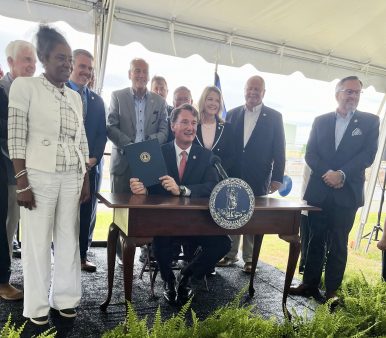On day three of a massive dockworkers’ strike that was resulting in runs at supermarkets on consumer goods like toilet paper, the International Longshoremen‘s Association (ILA) and the United States Maritime Alliance (USMX) announced a tentative agreement had been reached and work would resume in ports from Maine to Texas.
On Thursday evening, the ILA and the U.S. Maritime Alliance released a joint statement, announcing that the striking dockworkers and their employers “have reached a tentative agreement on wages and have agreed to extend the Master Contract until January 15, 2025 to return to the bargaining table to negotiate all other outstanding issues. Effective immediately, all current job actions will cease and all work covered by the Master Contract will resume.”
In a statement posted on X Thursday, President Joe Biden said, “I applaud the International Longshoremen’s Association and the United States Maritime Alliance for coming together to reopen the East Coast and Gulf ports and ensure the availability of critical supplies for Hurricane Helene recovery and rebuilding. Collective bargaining works.”
Thursday evening, the Port of Virginia posted on its website that it was “in the process of bringing our terminals back online in an orderly and safe manner,” which will take about 24 hours, officials estimate. The first reservation for motor carrier pickup will be available 24 hours after union workers return to work, and “as a result, motor carriers are encouraged to plan for longer-than-usual queue times and waits. We appreciate the patience of our customers and partners throughout this process.”
Rachel Shames, vice president of pricing and procurement for Norfolk-based logistics and trade compliance company CV International, said in an interview Tuesday that if the strike lasted “only a couple of days, we’ll avoid the worst of potential disruption.”
She noted that “May and June were very, very heavy shipping months, which was surprising, but it was really all because shippers were trying to get ahead of the situation. Some shippers are in better positions than others.”
Also, Shames said, “Since COVID, in particular, it’s been cycles of unpredictability. Basically, there’s not really a normal anymore in international shipping. It’s very volatile. So, in one sense, I think this is just another roadblock.”
Speaking Friday morning, after the strike’s suspension, Shames noted that although the wage dispute appears to be settled, “automation is the remaining sticking point.” However, “everybody’s excited we’ve got a few months of breathing room now,” she said. Moving forward, Shames expects about “two or three weeks of digging out” of the backlogged shipments, and some shippers could try to load more cargo in coming weeks before January 2025, when the temporary agreement ends.
“There’s hardly a ‘normal’ anymore,” Shames said. “That’s the shipping world — disruption.”
According to reports from The New York Times and The Wall Street Journal, port employers have offered the union dockworkers a 62% increase in wages over the six-year period of their next contract.
On Monday ahead of the strike, the ILA had been seeking a 61.5% pay increase. The USMX, which represents shipping employers such as Maersk’s APM Terminals, had previously proposed a 50% rise in wages, tripling employer contributions to worker retirement plans, strengthened health care options and “retaining … current language around automation and semi-automation.”
About 45,000 ILA union members hit picket lines just after midnight on Tuesday at the Port of Virginia and every other major port along the East and Gulf coasts, launching the ILA’s first U.S. port strike since 1977. The strike had sparked fears of long-term supply chain disruptions and added stress to the national economy in the month leading up to the 2024 presidential election.
During the contract extension period, the union and the USMX will continue negotiating the terms of the master contract, including previous sticking points such as overtime and ports automation.
In a statement Tuesday, ILA President Harold Daggett said that the union wants “absolute airtight language that there will be no automation or semi-automation.” In July, Daggett had posted on the union’s website that he had met with former President Donald Trump, who “promised to support the ILA in its opposition to automated terminals in the U.S.”
Two major East Coast ports — the Port of Virginia and the Port of New York and New Jersey — have semi-automated terminals. Labeled by National Review in 2022 as “America’s Most Automated Port,” the Port of Virginia has more than 90 semi-automated stacking cranes, many of which were installed nearly a decade ago.
The union dockworkers’ previous master contract had stated, “There shall be no implementation of semi-automated equipment or technology/automation until both parties agree to workforce protections and staffing levels.”
Virginia Business Deputy Editor Kate Andrews contributed to this article.




